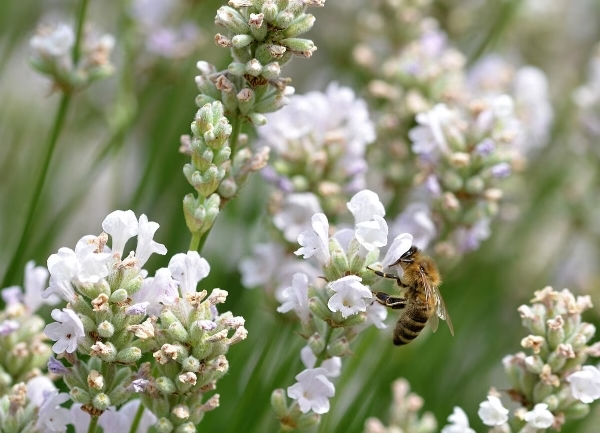
White Lavender
Botanical Name
:
Lavandula angustifolia
Plant Type
:
Herbaceous perennial
Seasons
:
Spring to summer (blooms in late spring to early summer)
Sun Level
:
Full sun (6–8 hours daily)
Ideal Soil Temperature for Planting
:
60-70°F (15-21°C)
Soil Type
:
Well-draining soils such as loam, sand, or shallow rocky soils
Hardiness Zones
:
5–9 (USDA)
Germination
:
Propagation is typically through cuttings rather than seeds due to maintaining desired traits like flower color
P.H. Level
:
Slightly alkaline to neutral (6.5–7.5)
Water/Irrigation
:
Low; water sparingly once established, allowing soil to dry between watering
Fertilization
:
Minimal fertilization is required. Apply a light, balanced fertilizer in early spring if needed
Habit
:
Mounded, bushy, aromatic foliage
Final Plant Height
:
18–24 inches (45–60 cm)
Spread
:
24–36 inches (60–90 cm)
Spacing
:
12–18 inches apart to allow for air circulation
Flowers
:
Small, fragrant, white flowers on tall spikes in late spring to early summer. Some varieties have purple-flushed white flowers like “White Scent”
Attracts
:
Bees, butterflies, hummingbirds
Uses
:
Aromatherapy, herbal medicine, ornamental gardens, dried flowers, potpourri, culinary uses
Companions
:
Rosemary, sage, echinacea, yarrow, catmint
Pruning
:
Prune back by one-third in early spring to encourage bushy growth. Deadhead spent flowers to promote reblooming
Toxicity
:
Non-toxic to humans but mildly toxic to pets if ingested in large amounts
Pests
:
Generally pest-resistant but may attract aphids or whiteflies
Diseases
:
Susceptible to root rot if overwatered, as well as fungal infections in humid conditions
Botanical Name
:
Lavandula angustifolia
Plant Type
:
Herbaceous perennial
Seasons
:
Spring to summer (blooms in late spring to early summer)
Sun Level
:
Full sun (6–8 hours daily)
Ideal Soil Temperature for Planting
:
60-70°F (15-21°C)
Soil Type
:
Well-draining soils such as loam, sand, or shallow rocky soils
Hardiness Zones
:
5–9 (USDA)
Germination
:
Propagation is typically through cuttings rather than seeds due to maintaining desired traits like flower color
P.H. Level
:
Slightly alkaline to neutral (6.5–7.5)
Water/Irrigation
:
Low; water sparingly once established, allowing soil to dry between watering
Fertilization
:
Minimal fertilization is required. Apply a light, balanced fertilizer in early spring if needed
Habit
:
Mounded, bushy, aromatic foliage
Final Plant Height
:
18–24 inches (45–60 cm)
Spread
:
24–36 inches (60–90 cm)
Spacing
:
12–18 inches apart to allow for air circulation
Flowers
:
Small, fragrant, white flowers on tall spikes in late spring to early summer. Some varieties have purple-flushed white flowers like “White Scent”
Attracts
:
Bees, butterflies, hummingbirds
Uses
:
Aromatherapy, herbal medicine, ornamental gardens, dried flowers, potpourri, culinary uses
Companions
:
Rosemary, sage, echinacea, yarrow, catmint
Pruning
:
Prune back by one-third in early spring to encourage bushy growth. Deadhead spent flowers to promote reblooming
Toxicity
:
Non-toxic to humans but mildly toxic to pets if ingested in large amounts
Pests
:
Generally pest-resistant but may attract aphids or whiteflies
Diseases
:
Susceptible to root rot if overwatered, as well as fungal infections in humid conditions
Written by Salome Wapukha – https://www.linkedin.com/in/salome-wapukha-556700193/

